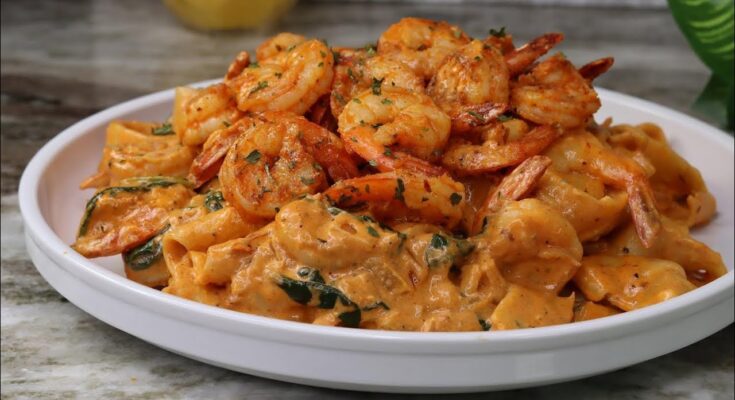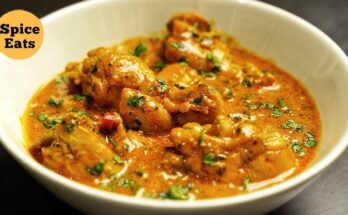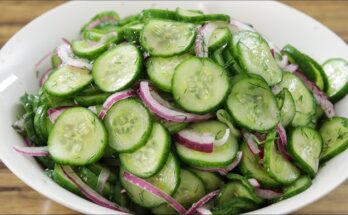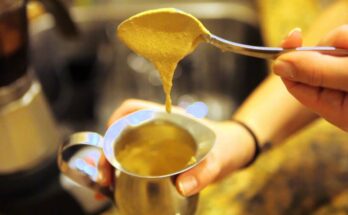Cajun Shrimp Recipe: Cajun shrimp isn’t just another seafood dish—it’s a flavor-packed, spicy sensation that brings a taste of Louisiana right into your kitchen. What makes it truly irresistible is the harmonious blend of bold spices, fresh shrimp, and rich, buttery undertones. Unlike typical shrimp recipes, Cajun shrimp thrives on the smoky heat of paprika, the punch of garlic powder, and the fiery touch of cayenne. It’s a dish that excites your taste buds and keeps you reaching for more.
Cajun shrimp is incredibly versatile. You can toss it into pasta, pile it over rice, or even tuck it into tacos. Whether you’re whipping it up for a weeknight dinner or serving it as the star of your weekend get-together, it always steals the show. The best part? It’s quick and simple, taking only about 20 minutes from start to finish. No fancy cooking skills needed—just fresh ingredients and a little spice magic.
A Brief History of Cajun Cuisine
To understand Cajun shrimp, you’ve got to understand Cajun cuisine. Born from French-speaking Acadian immigrants who settled in Louisiana in the 18th century, Cajun food is all about resourcefulness and heart. It blends French culinary traditions with local ingredients like seafood, rice, and spices, resulting in rich, hearty meals designed to feed the soul.
What’s unique is the layering of flavors. Every Cajun dish starts with the “holy trinity” of cooking: onions, bell peppers, and celery. Add in a generous dose of seasoning, and you’ve got a deeply flavorful base that elevates everything—especially shrimp. The use of spices is not just for heat, but to bring out the character of each ingredient. This history and technique are what give Cajun shrimp its unforgettable depth.
Ingredients for the Perfect Cajun Shrimp
Essential Ingredients You’ll Need
To make the perfect Cajun shrimp, you’ll want to gather a few key ingredients. Here’s a breakdown of what you need for four servings:
- 1 lb large shrimp (peeled and deveined)
- 2 tablespoons olive oil
- 2 tablespoons butter
- 3 cloves garlic (minced)
- 1 tablespoon paprika (smoked for extra depth)
- 1 teaspoon cayenne pepper
- 1 teaspoon onion powder
- 1 teaspoon dried oregano
- 1/2 teaspoon thyme
- Salt and black pepper (to taste)
- Juice of half a lemon
- Fresh parsley (chopped, for garnish)
This mix creates a bold, aromatic base that pairs beautifully with the natural sweetness of shrimp. Don’t skip the butter—it adds a richness that balances the spice. And that lemon? It brings the perfect bright finish.
Optional Add-ins for Extra Flavor
Want to take your Cajun shrimp to the next level? Consider these optional add-ins:
- Sliced andouille sausage: Adds a smoky, meaty bite.
- Diced bell peppers: Brightens the dish with a slight crunch and sweetness.
- Creole mustard: A spoonful mixed into the pan sauce adds tang and complexity.
- Hot sauce: For those who crave a little extra fire.
- A splash of white wine: Elevates the dish with a hint of acidity and depth.
You can also experiment with serving styles—try Cajun shrimp over creamy grits, buttery mashed potatoes, or even inside a toasted po’boy bun with remoulade. The flexibility is endless, which is exactly why it’s a go-to for so many home cooks.
Preparing the Shrimp
How to Choose the Right Shrimp
Shrimp is the star here, so picking the right kind is key. Look for large or jumbo shrimp—they’re meatier and hold up better to bold Cajun seasoning. Whether fresh or frozen, make sure they’re peeled and deveined for easy prep.
Wild-caught Gulf shrimp are ideal if you can find them. They’re plumper, have a better flavor, and fit the regional theme perfectly. If buying frozen, ensure they’re raw and not pre-cooked—pre-cooked shrimp can turn rubbery when reheated.
Pro Tip: Look at the count per pound (like 16/20). The lower the number, the bigger the shrimp.
Cleaning and Deveining Tips
Even if you buy peeled shrimp, you’ll want to double-check for that vein. Cleaning shrimp properly ensures a better texture and cleaner flavor. Here’s a quick method:
- Rinse the shrimp under cold water.
- Use a paring knife to make a shallow cut along the back.
- Pull out the dark vein with the tip of your knife or your fingers.
- Pat dry with paper towels.
Dry shrimp sear better, helping you achieve that slightly crispy exterior while locking in juicy flavor.
Making the Cajun Seasoning
Homemade Cajun Spice Mix
Making your own Cajun spice blend lets you control the flavor and heat. Here’s a simple recipe:
- 2 tbsp paprika (smoked or sweet)
- 1 tbsp garlic powder
- 1 tbsp onion powder
- 1 tsp cayenne pepper
- 1 tsp black pepper
- 1 tsp white pepper
- 1 tsp thyme
- 1 tsp oregano
- 1 tsp salt
Mix these in a bowl and store in an airtight jar. It’s great on chicken, fish, veggies, and even fries!
Store-Bought vs Homemade: What’s Better?
Store-bought Cajun seasoning is convenient, sure. But it often includes preservatives, unnecessary sodium, and lacks the vibrant punch of a homemade blend. Going DIY means you tailor the heat and saltiness to your liking.
If you do go for store-bought, check the label—opt for blends with minimal ingredients and no MSG. Brands like Slap Ya Mama or Tony Chachere’s are Louisiana classics, but be cautious of the salt content.
Cooking Cajun Shrimp
Sautéing to Perfection
Sautéing is the quickest and most popular method. Here’s how to do it right:
- Heat olive oil and butter in a skillet over medium-high heat.
- Add minced garlic and cook for 30 seconds.
- Toss in the shrimp and your Cajun seasoning mix.
- Cook for 2-3 minutes per side until shrimp curl and turn pink.
- Squeeze in lemon juice and garnish with parsley.
Don’t overcrowd the pan—cook in batches if needed. Overcooking will toughen the shrimp, so keep an eye out for that golden pink color.
Grilling vs Pan-frying – Which One’s for You?
Grilling imparts a smoky, charred flavor that’s hard to beat—perfect for BBQs. Thread seasoned shrimp onto skewers and grill for 2 minutes per side. Great for outdoor vibes.
Pan-frying is ideal for weeknights—fast, flavorful, and no fuss. Just be sure to use a cast-iron skillet if possible for the best sear.
Serving Suggestions for Cajun Shrimp
Classic Pairings That Work Every Time
Cajun shrimp is delicious enough to shine on its own, but pairing it with the right side dishes can elevate your meal to new heights. Here are a few classic combos that bring out the best in this fiery favorite:
- Cajun Shrimp Pasta: Toss your shrimp into creamy Alfredo pasta or spicy tomato-based sauce for a comforting Southern-style dish.
- Shrimp and Grits: This traditional Southern favorite features creamy, cheesy grits topped with juicy shrimp and a buttery pan sauce.
- Jambalaya or Dirty Rice: The bold flavors of jambalaya are a perfect match, turning your Cajun shrimp into a hearty, one-pot meal.
- Steamed White Rice or Cilantro Lime Rice: A simple rice base lets the shrimp flavor shine while offering a nice balance to the spice.
- Crusty French Bread: Use it to mop up every last bit of that buttery, garlicky sauce—trust me, you won’t regret it.
And for an ultra-refreshing twist, try serving it with a crisp garden salad or a tangy coleslaw to cut through the spice.
Creative Ways to Serve Cajun Shrimp
Feeling adventurous? Cajun shrimp can be reimagined in lots of fun, creative ways:
- Cajun Shrimp Tacos: Load your shrimp into soft tortillas with shredded cabbage, avocado, and a drizzle of lime crema.
- Shrimp Po’ Boys: A New Orleans classic—pile your shrimp high in a toasted baguette with lettuce, tomato, and spicy mayo.
- Cajun Shrimp Skewers: Perfect for parties. Grill them up and serve with a dipping sauce like remoulade or garlic aioli.
- Shrimp Bowls: Build a nutritious meal with a base of quinoa or brown rice, some grilled veggies, and a few shrimp tossed on top.
- Lettuce Wraps: A low-carb favorite! Use butter lettuce to wrap spicy shrimp, shredded carrots, and crunchy cucumber.
Cajun shrimp is as versatile as it is tasty, so feel free to get creative with your presentation and mix up your sides!
Tips for Perfect Cajun Shrimp Every Time
Common Mistakes to Avoid
Even a simple dish like Cajun shrimp can go sideways if you’re not careful. Here are a few pitfalls to dodge:
- Overcooking the Shrimp: This is the #1 mistake. Shrimp cooks fast—like 2-3 minutes per side. Overcooked shrimp becomes rubbery and dry.
- Using Pre-Cooked Shrimp: Skip it! Reheating pre-cooked shrimp leads to blandness and a weird texture.
- Under-seasoning: Cajun shrimp should be bold and flavorful. Don’t be shy with the seasoning—but balance it well.
- Not Letting the Spices Bloom: Sautéing the seasoning with butter or oil helps release its aromatic flavors. Skipping this step leaves your dish flat.
- Forgetting Acidity: A splash of lemon or lime juice brightens up the whole dish and balances the richness.
Pro Chef Tips for Flavor Enhancement
Want to make your Cajun shrimp restaurant-quality? Try these pro-level tricks:
- Marinate Your Shrimp: Even 15 minutes in the spice mix and olive oil can boost flavor.
- Use a Cast-Iron Skillet: It retains heat better and gives the shrimp a crispy sear.
- Finish with Compound Butter: A dollop of garlic-herb butter at the end melts into the shrimp and adds luxury.
- Deglaze the Pan: After sautéing, splash in a bit of wine or broth and scrape up the flavorful bits to make a simple sauce.
- Garnish Smart: Use fresh herbs like parsley or green onion for color and brightness.
Small touches make a big difference. Think of your kitchen as your playground—don’t be afraid to experiment!
Cajun Shrimp for Special Diets
Making It Keto or Low-Carb
Good news: Cajun shrimp is naturally low in carbs and packed with protein, making it perfect for keto lovers. Just skip starchy sides like rice or pasta and serve it with cauliflower rice or steamed veggies instead.
Here’s a quick keto Cajun shrimp bowl idea:
- Cajun shrimp
- Cauliflower rice sautéed with garlic and onion
- Avocado slices
- Spinach or arugula
- A drizzle of lime or chipotle mayo
You can also use coconut oil or ghee instead of butter if you’re dairy-free.
Gluten-Free and Dairy-Free Variations
Making Cajun shrimp gluten-free is a breeze—most homemade Cajun spice blends are naturally gluten-free. Just double-check any store-bought seasoning or sauces for hidden gluten.
For dairy-free diets, replace butter with olive oil or a dairy-free butter substitute. The flavor remains rich and delicious without the dairy.
Pro Tip: Add a little coconut cream to your sauce for a tropical twist that works especially well if you’re pairing with mango salsa or grilled pineapple.
Storing and Reheating Cajun Shrimp
How to Store Leftovers Properly
Cajun shrimp is so good, it’s rare you’ll have leftovers—but if you do, here’s how to store them right:
- Refrigeration: Place your shrimp in an airtight container and store in the fridge for up to 3 days. Be sure to let them cool completely before sealing.
- Freezing: You can freeze cooked shrimp, though it’s best enjoyed fresh. If freezing, use a freezer-safe bag or container. They’ll last up to 2 months, but the texture may change slightly upon reheating.
Avoid leaving shrimp out at room temperature for more than 2 hours to prevent bacterial growth.
Best Reheating Methods
Reheating shrimp without overcooking it can be tricky. Here’s how to do it right:
- Stovetop (Best method): Add a little butter or olive oil to a skillet, and heat shrimp over medium-low heat just until warmed through—about 2-3 minutes.
- Microwave: Place shrimp in a microwave-safe dish, cover with a damp paper towel, and heat in 30-second bursts, stirring in between.
- Oven: Wrap shrimp in foil with a bit of water or broth and bake at 300°F (150°C) for about 10 minutes.
Always reheat gently to preserve that juicy, tender texture.
Health Benefits of Cajun Shrimp
Nutritional Highlights
Shrimp may be small, but they’re mighty when it comes to nutrition:
- High in Protein: A 3-ounce serving offers over 20 grams of lean protein.
- Low in Calories: Perfect for weight-conscious eaters, shrimp are naturally low in fat and calories.
- Rich in Nutrients: Contains selenium, vitamin B12, and iodine—important for thyroid health and brain function.
- Omega-3 Fatty Acids: While not as rich as salmon, shrimp still provides heart-healthy omega-3s.
Paired with spices like paprika and garlic—known for their anti-inflammatory properties—Cajun shrimp is not just delicious, but good for you too.
Allergy and Diet Considerations
Of course, shrimp is a shellfish, so if you or anyone in your household has a seafood allergy, skip this recipe altogether.
If you’re watching sodium levels, reduce the salt in your Cajun mix or opt for a no-salt version. Most of the flavor comes from the spices anyway.
Vegetarian or vegan? You can still enjoy the flavors by substituting shrimp with tofu, cauliflower, or even mushrooms. Just season and cook the same way!
FAQs about Cajun Shrimp Recipe
1. What is Cajun shrimp made of?
Cajun shrimp is typically made with large shrimp tossed in a bold spice mix of paprika, garlic powder, onion powder, cayenne pepper, oregano, thyme, salt, and black pepper. It’s then sautéed in butter or olive oil—sometimes with a splash of lemon juice or a garlic twist for extra punch.
2. Is Cajun shrimp spicy?
Yes, Cajun shrimp has a kick! But the heat level is customizable. You can tone it down by reducing the cayenne pepper or balance the spice with a bit of honey or cream sauce.
3. How long does it take to cook Cajun shrimp?
Not long at all! Cajun shrimp cooks in just 5–7 minutes on a hot skillet. Once the shrimp turns pink and curls slightly, it’s done. Overcooking will make it rubbery, so keep an eye on it.
4. Can I use frozen shrimp?
Absolutely. Just make sure to thaw it completely and pat it dry with paper towels. Wet shrimp won’t sear properly, and you’ll lose that lovely caramelized crust.
5. What goes well with Cajun shrimp?
Cajun shrimp pairs perfectly with rice, pasta, or mashed potatoes. Want low-carb? Serve it over sautéed veggies or a crisp salad. Crusty bread is also a great side to soak up all that spicy goodness!
6. Can I make Cajun shrimp in advance?
It’s best fresh, but you can prep the seasoning and clean the shrimp ahead of time. If you must reheat, do so gently to avoid rubbery texture—low heat on the stovetop works best.
7. Is Cajun shrimp healthy?
Yes—shrimp is low in calories and high in protein. If you cook it in olive oil and avoid cream-heavy sauces, it’s a healthy and satisfying option for any meal plan.
Conclusion
Cajun shrimp isn’t just a dish—it’s a full-on flavor adventure. With its spicy, buttery richness and quick-cook charm, it’s a recipe that belongs in every home cook’s rotation. Whether you’re serving it up over grits, tucking it into tacos, or savoring it straight from the skillet, this dish delivers comfort and heat in every bite.
And the best part? You can tweak it to match your heat tolerance, dietary needs, or creative whims. From weekday dinners to weekend feasts, Cajun shrimp is always a crowd-pleaser.
So grab that skillet, crank up the spice, and get cooking. Your taste buds will thank you.



